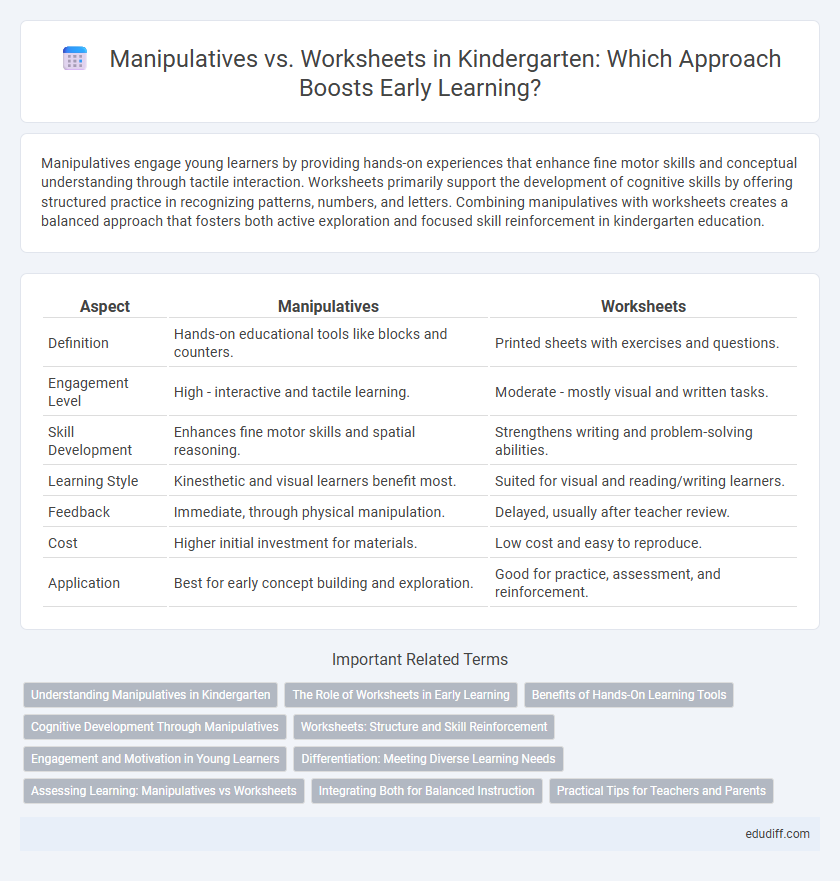Manipulatives engage young learners by providing hands-on experiences that enhance fine motor skills and conceptual understanding through tactile interaction. Worksheets primarily support the development of cognitive skills by offering structured practice in recognizing patterns, numbers, and letters. Combining manipulatives with worksheets creates a balanced approach that fosters both active exploration and focused skill reinforcement in kindergarten education.
Table of Comparison
| Aspect | Manipulatives | Worksheets |
|---|---|---|
| Definition | Hands-on educational tools like blocks and counters. | Printed sheets with exercises and questions. |
| Engagement Level | High - interactive and tactile learning. | Moderate - mostly visual and written tasks. |
| Skill Development | Enhances fine motor skills and spatial reasoning. | Strengthens writing and problem-solving abilities. |
| Learning Style | Kinesthetic and visual learners benefit most. | Suited for visual and reading/writing learners. |
| Feedback | Immediate, through physical manipulation. | Delayed, usually after teacher review. |
| Cost | Higher initial investment for materials. | Low cost and easy to reproduce. |
| Application | Best for early concept building and exploration. | Good for practice, assessment, and reinforcement. |
Understanding Manipulatives in Kindergarten
Understanding manipulatives in kindergarten enhances hands-on learning by allowing children to explore concepts like counting, shapes, and patterns through physical interaction. Manipulatives such as blocks, beads, and puzzles promote fine motor skills development and foster critical thinking more effectively than worksheets alone. Integrating manipulatives supports diverse learning styles and improves conceptual understanding in early childhood education.
The Role of Worksheets in Early Learning
Worksheets in early learning provide structured practice that reinforces foundational skills such as letter recognition, number tracing, and basic problem-solving, supporting cognitive development. They offer measurable outcomes that help educators assess a child's progress and identify areas needing improvement. Incorporating worksheets alongside hands-on manipulatives ensures balanced sensory engagement and conceptual understanding in kindergarten education.
Benefits of Hands-On Learning Tools
Hands-on learning tools like manipulatives enhance fine motor skills and foster concrete understanding of abstract concepts in kindergarten. They promote active engagement, critical thinking, and problem-solving abilities by allowing children to explore and experiment in a tactile way. Research shows that manipulatives increase retention and comprehension, making them more effective than traditional worksheets for early childhood education.
Cognitive Development Through Manipulatives
Manipulatives enhance cognitive development in kindergarten by promoting hands-on learning and improving problem-solving skills. These tactile tools support spatial awareness, fine motor development, and abstract thinking far more effectively than traditional worksheets. Research shows that children using manipulatives demonstrate increased engagement and deeper conceptual understanding in early math and literacy tasks.
Worksheets: Structure and Skill Reinforcement
Worksheets provide a structured format that helps kindergarten students practice specific skills consistently, fostering mastery through repetition. They reinforce foundational concepts like counting, letter recognition, and basic math operations by offering clear, measurable tasks. The organized layout of worksheets supports systematic skill development and allows teachers to easily assess individual progress.
Engagement and Motivation in Young Learners
Manipulatives significantly enhance engagement and motivation in young learners by providing hands-on, tactile experiences that make abstract concepts concrete and understandable. Unlike worksheets, which often promote passive learning, manipulatives foster active participation, boosting curiosity and sustained attention in kindergarten settings. Research shows that children using manipulatives demonstrate higher retention rates and a more positive attitude toward learning activities compared to those relying solely on paper-based tasks.
Differentiation: Meeting Diverse Learning Needs
Manipulatives in kindergarten offer tactile and visual learning experiences that cater to kinesthetic and spatial learners, enhancing concept comprehension through hands-on interaction. Worksheets provide structured opportunities for practicing skills and assessing individual progress, supporting auditory and visual learners who benefit from written and visual instructions. Combining manipulatives with customized worksheets allows educators to differentiate instruction effectively, addressing diverse learning styles and developmental levels in the classroom.
Assessing Learning: Manipulatives vs Worksheets
Manipulatives provide concrete, hands-on experiences that allow educators to assess a child's understanding of concepts through active engagement and problem-solving skills. Worksheets primarily measure a child's ability to recall information and complete tasks independently, offering a more standardized form of assessment. Combining both methods delivers a comprehensive evaluation of a child's cognitive and fine motor development in kindergarten.
Integrating Both for Balanced Instruction
Integrating manipulatives and worksheets in kindergarten instruction enhances cognitive development by combining hands-on learning with structured practice. Manipulatives support fine motor skills and concrete understanding of concepts like counting or shapes, while worksheets reinforce these skills through repetition and written expression. A balanced approach ensures diverse engagement, catering to different learning styles and improving overall mastery of foundational skills.
Practical Tips for Teachers and Parents
Manipulatives like blocks and puzzles enhance fine motor skills and promote hands-on learning, making difficult concepts more tangible for kindergarteners. Worksheets, while useful for reinforcing specific skills and tracking progress, should be balanced with interactive activities to maintain engagement and cater to diverse learning styles. Teachers and parents can integrate manipulatives with targeted worksheets by using physical tools to introduce new ideas, then applying worksheets for practice and assessment.
Manipulatives vs Worksheets Infographic

 edudiff.com
edudiff.com